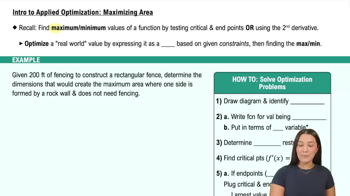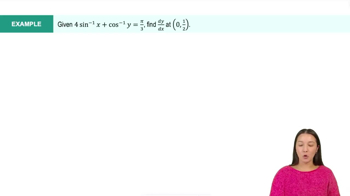Optimization A right triangle has legs of length h and r and a hypotenuse of length 4 (see figure). It is revolved about the leg of length h to sweep out a right circular cone. What values of h and r maximize the volume of the cone? (Volume of a cone = (1/3) πr²h.) <IMAGE>
Table of contents
- 0. Functions7h 54m
- Introduction to Functions16m
- Piecewise Functions10m
- Properties of Functions9m
- Common Functions1h 8m
- Transformations5m
- Combining Functions27m
- Exponent rules32m
- Exponential Functions28m
- Logarithmic Functions24m
- Properties of Logarithms36m
- Exponential & Logarithmic Equations35m
- Introduction to Trigonometric Functions38m
- Graphs of Trigonometric Functions44m
- Trigonometric Identities47m
- Inverse Trigonometric Functions48m
- 1. Limits and Continuity2h 2m
- 2. Intro to Derivatives1h 33m
- 3. Techniques of Differentiation3h 18m
- 4. Applications of Derivatives2h 38m
- 5. Graphical Applications of Derivatives6h 2m
- 6. Derivatives of Inverse, Exponential, & Logarithmic Functions2h 37m
- 7. Antiderivatives & Indefinite Integrals1h 26m
- 8. Definite Integrals4h 44m
- 9. Graphical Applications of Integrals2h 27m
- 10. Physics Applications of Integrals 3h 16m
- 11. Integrals of Inverse, Exponential, & Logarithmic Functions2h 31m
- 12. Techniques of Integration7h 41m
- 13. Intro to Differential Equations2h 55m
- 14. Sequences & Series5h 36m
- 15. Power Series2h 19m
- 16. Parametric Equations & Polar Coordinates7h 58m
5. Graphical Applications of Derivatives
Applied Optimization
Problem 61
Textbook Question
The sum of two nonnegative numbers is 36. Find the numbers if
a. the difference of their square roots is to be as large as possible.
b. the sum of their square roots is to be as large as possible.
 Verified step by step guidance
Verified step by step guidance1
Step 1: Define the two nonnegative numbers as x and y, with the constraint x + y = 36.
Step 2: For part (a), express the difference of their square roots as |√x - √y|. To maximize this difference, consider the function f(x) = √x - √(36 - x) and find its critical points by taking the derivative and setting it to zero.
Step 3: Calculate the derivative of f(x) with respect to x, which is f'(x) = (1/(2√x)) - (1/(2√(36-x))). Set f'(x) = 0 to find the critical points.
Step 4: Solve the equation (1/(2√x)) = (1/(2√(36-x))) to find the value of x that maximizes the difference of square roots. Check the endpoints x = 0 and x = 36 to ensure the maximum is within the interval.
Step 5: For part (b), express the sum of their square roots as √x + √y. To maximize this sum, consider the function g(x) = √x + √(36 - x) and find its critical points by taking the derivative and setting it to zero. Follow similar steps as in part (a) to find the value of x that maximizes the sum of square roots.
 Verified video answer for a similar problem:
Verified video answer for a similar problem:This video solution was recommended by our tutors as helpful for the problem above
Video duration:
5mPlay a video:
Was this helpful?
Key Concepts
Here are the essential concepts you must grasp in order to answer the question correctly.
Optimization
Optimization in calculus involves finding the maximum or minimum values of a function within a given domain. In this problem, we need to optimize the difference and sum of the square roots of two nonnegative numbers, subject to the constraint that their sum is 36. This typically involves using techniques such as derivatives to find critical points.
Recommended video:

Intro to Applied Optimization: Maximizing Area
Constraints
Constraints are conditions that must be satisfied in an optimization problem. Here, the constraint is that the sum of the two nonnegative numbers equals 36. Understanding how to express one variable in terms of another using this constraint is crucial for setting up the optimization equations.
Recommended video:

Intro to Applied Optimization: Maximizing Area
Square Roots
Square roots are mathematical functions that return a nonnegative number whose square equals the given number. In this context, we are interested in the properties of square roots to maximize their difference and sum. Recognizing how square roots behave, especially in relation to their inputs, is essential for solving the optimization problems presented.
Recommended video:

Derivatives of Inverse Sine & Inverse Cosine Example 1

 1:13m
1:13mWatch next
Master Intro to Applied Optimization: Maximizing Area with a bite sized video explanation from Patrick
Start learningRelated Videos
Related Practice
Textbook Question
